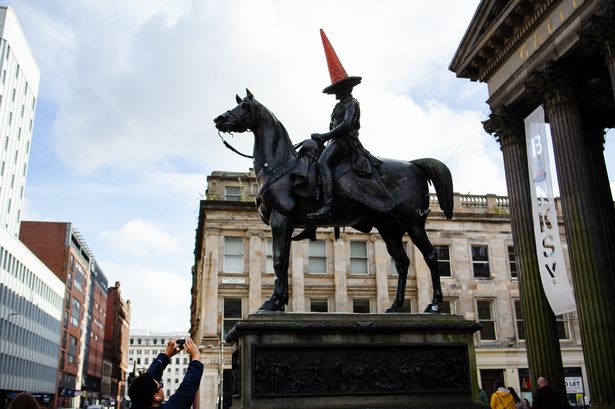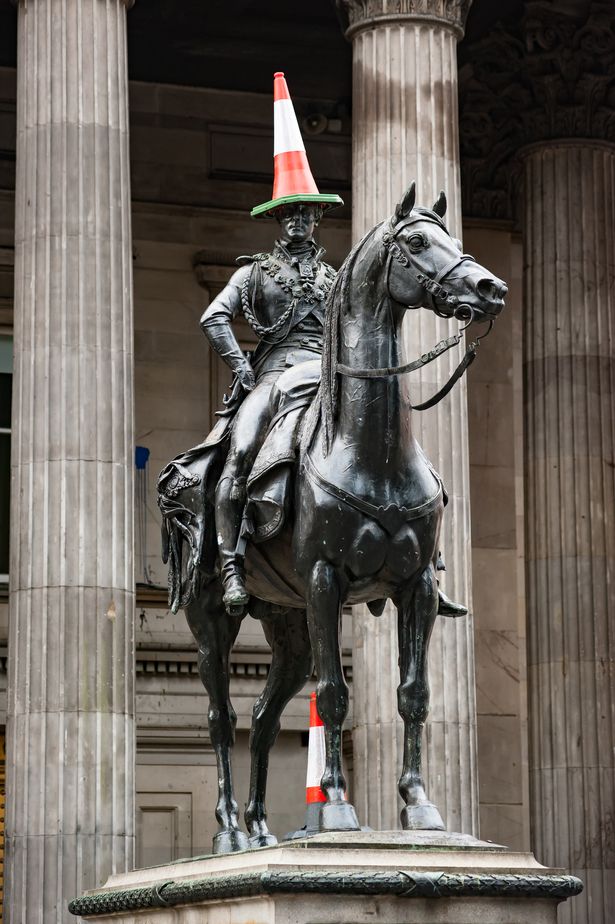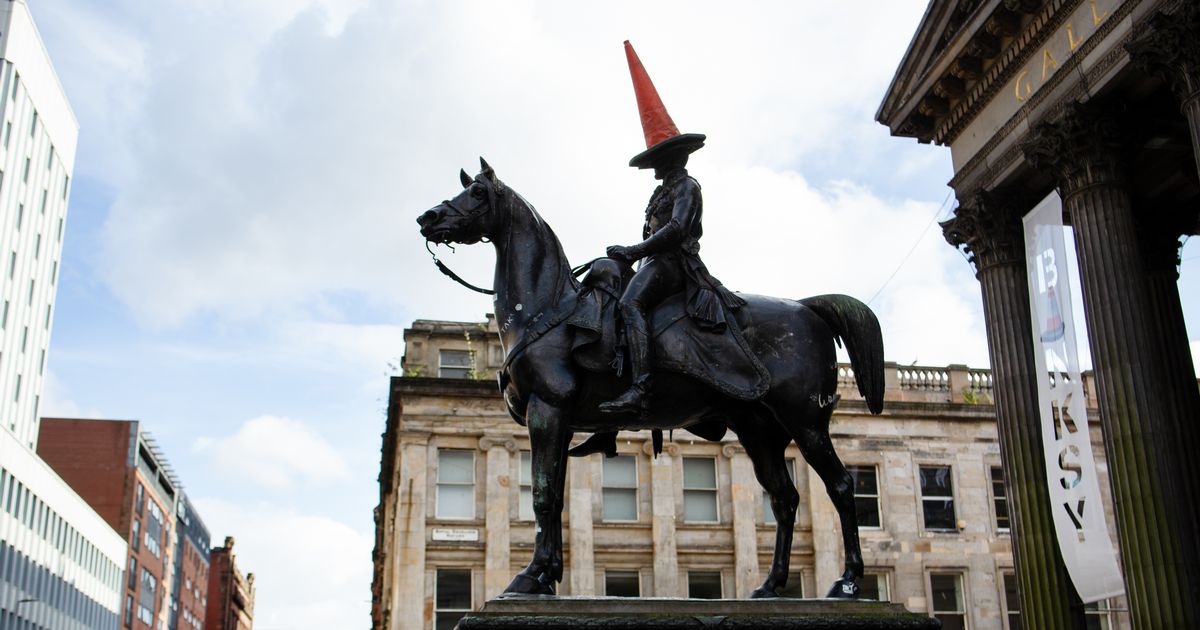The grey plaque outside 100 Queen Street, facing the statue, reveals the “unbelievable” origin of Glasgow’s famous cone tradition. A plaque near the Duke of Wellington statue on Queen Street humorously claims to reveal the “Ancient Tradition Behind The Cones On Glasgow’s Statues.”(Image: Emily Macinnes/Bloomberg via Getty Images)
A plaque near the Duke of Wellington statue on Queen Street humorously claims to reveal the “Ancient Tradition Behind The Cones On Glasgow’s Statues.”(Image: Emily Macinnes/Bloomberg via Getty Images)
A plaque near one of Glasgow’s most iconic landmarks is capturing people’s attention online, after claiming to reveal the “Ancient Tradition Behind The Cones On Glasgow’s Statues”.
Located just outside 100 Queen Street, directly facing the Duke of Wellington statue, the grey circular sign appears fixed to a black box, and it’s not what it seems. The so-called explanation behind the now world-famous tradition of placing traffic cones on the Duke’s head is, in fact, an elaborate and hilarious work of street art, Glasgow Live reports.
The plaque is the latest creation from the Glasgow Information and Kultural Identity Taskforce, better known as GlaIKIT, a tongue-in-cheek collective of “rogue historians” responsible for installing similar plaques across the city.
Content cannot be displayed without consent
Their latest handiwork outlines the bizarre origins of a tradition they call “Coning”, claiming it stretches back “hundreds, if not thousands, of years to the clans of the Scottish Highlands”.
The plaque reads: “Here, a man seeking to wed a chieftain’s daughter would be challenged to place a cone fashioned from the pelt of a haggis on the top of an eighty-foot grease-covered pole while the woman’s male relatives sought to stop him. If he succeeded, he’d win her hand in marriage, but if he failed he’d instantly be put to death.”
Over time, it explains, the deadly rite evolved into a bizarre Highland sport, where “hundreds of men, naked except for their sporrans, would fight to be the first to place their cone on the summit of a tall, slippery pole”.
When Highlanders began migrating to Glasgow during the 1800s, the sport allegedly took root in the city’s working class communities.
 The plaque claims the traffic cones on the Duke of Wellington statue stem from an ancient Highland tradition called “Coning.”(Image: Getty Images)
The plaque claims the traffic cones on the Duke of Wellington statue stem from an ancient Highland tradition called “Coning.”(Image: Getty Images)
“By 1900 onwards, large groups of near-naked Glaswegians could be found across the city competing to place a haggis-skin cone on top of a greasy pole,” it claims.
However, the government eventually stepped in, banning Coning poles over concerns about productivity due to the many injuries sustained during the sport.
“But the ever-resourceful locals simply switched to competing to place cones on the heads of public statues instead, many of which depicted the very same politicians who’d tried to eradicate the sport.”
According to the plaque, the tradition adapted with the times. “By the 1950s, plastic traffic cones had replaced the original haggis skin ones,” it continues, “and in the 2010s, the sport’s practitioners, known as coneheads, began a campaign to have Coning recognised and protected under the UNESCO 2003 Convention for the Safeguarding of Intangible Cultural Heritage.”
The plaque concludes saying: “This was finally granted on the 1st of April 2024 so enshrining in law the right of every drunken Glaswegian to climb a greased-up statue while naked except for a sporran in an attempt to be the first to place a cone on its head.”
Visitors are then directed to GlaIKIT’s official website, which offers more “extraordinary tales from Glasgow’s rich and vibrant past”, stories, they admit, that have been “overlooked by other historians of the city for far too long simply because there’s absolutely no evidence they ever happened”.
 Join the Daily Record WhatsApp community!
Join the Daily Record WhatsApp community!
Get the latest news sent straight to your messages by joining our WhatsApp community today.
You’ll receive daily updates on breaking news as well as the top headlines across Scotland.
No one will be able to see who is signed up and no one can send messages except the Daily Record team.
All you have to do is click here if you’re on mobile, select ‘Join Community’ and you’re in!
If you’re on a desktop, simply scan the QR code above with your phone and click ‘Join Community’.
We also treat our community members to special offers, promotions, and adverts from us and our partners. If you don’t like our community, you can check out any time you like.
To leave our community click on the name at the top of your screen and choose ‘exit group’.
If you’re curious, you can read our Privacy Notice.
Unbothered by such technicalities, GlaIKIT says it proudly “never let a little thing like the truth get in the way of telling a good story”.
“When we come across a story we feel is particularly interesting, we award it a GlaIKIT Silver Plaque which we then put up in an appropriate location around the city,” their site explains.
“This gives it our official seal of approval, meaning you can be certain it really must be true because of all the detailed drinking, I mean research, that we do.”
So far, five GlaIKIT Silver Plaques have popped up across Glasgow, with more promised, just as soon as the team finishes its next round of “research” in as many local pubs and bars as their budget will allow.
